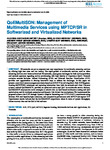QoEMultiSDN: Management of Multimedia Services using MPTCP/SR in Softwarized and Virtualized Networks
| dc.contributor.author | Barakabitze, AA | |
| dc.contributor.author | Mkwawa, Is-Haka | |
| dc.contributor.author | Hines, A | |
| dc.contributor.author | Sun, Lingfen | |
| dc.contributor.author | Ifeachor, Emmanuel | |
| dc.date.accessioned | 2021-11-12T14:11:42Z | |
| dc.date.available | 2021-11-12T14:11:42Z | |
| dc.date.issued | 2020-11-23 | |
| dc.identifier.issn | 2169-3536 | |
| dc.identifier.issn | 2169-3536 | |
| dc.identifier.uri | http://hdl.handle.net/10026.1/18347 | |
| dc.description.abstract |
5G networks are set to empower new user experiences for multimedia streaming services by offering high data rates and low latency. The rapid growth of multimedia services, such as video streaming services over future softwarized 5G networks, poses great challenges for both service providers and network operators regarding service provisioning with high Quality of Experience (QoE). Network evolution towards Software Defined Networking (SDN) and Network Function Virtualization (NFV) provides new opportunities to develop innovative ways to address the challenges. In this paper, we present a novel QoE-aware management scheme based on SDN/NFV by utilizing Multi-Path-TCP/Segment-Routing (MPTCP/SR) techniques and exploring information from both the network and client. The new scheme, entitled QoEMultiSDN, provides an optimized end-to-end QoE for multimedia service delivery. QoEMultiSDN employs two novel strategies to achieve this: (a) QoE-based multisource routing and QoE optimization, and (b) multipath protection and dynamic link-failure-free mechanisms. We implemented the proposed scheme over SDN through Dynamic Adaptive Streaming over HTTP (DASH) experiments using Mininet, POX and OpenDaylight controllers, and compared its performance with MPTCP and regular TCP. Experimental results indicate that the QoEMultiSDN outperforms others in terms of system throughput, failure recovery time and the QoE of the end-user. | |
| dc.format.extent | 1-1 | |
| dc.language.iso | en | |
| dc.publisher | Institute of Electrical and Electronics Engineers | |
| dc.title | QoEMultiSDN: Management of Multimedia Services using MPTCP/SR in Softwarized and Virtualized Networks | |
| dc.type | journal-article | |
| dc.type | Journal Article | |
| plymouth.issue | 99 | |
| plymouth.volume | PP | |
| plymouth.publication-status | Published | |
| plymouth.journal | IEEE Access | |
| dc.identifier.doi | 10.1109/access.2020.3039953 | |
| plymouth.organisational-group | /Plymouth | |
| plymouth.organisational-group | /Plymouth/Faculty of Science and Engineering | |
| plymouth.organisational-group | /Plymouth/Faculty of Science and Engineering/School of Engineering, Computing and Mathematics | |
| plymouth.organisational-group | /Plymouth/REF 2021 Researchers by UoA | |
| plymouth.organisational-group | /Plymouth/REF 2021 Researchers by UoA/UoA11 Computer Science and Informatics | |
| plymouth.organisational-group | /Plymouth/REF 2021 Researchers by UoA/UoA12 Engineering | |
| plymouth.organisational-group | /Plymouth/Users by role | |
| plymouth.organisational-group | /Plymouth/Users by role/Academics | |
| plymouth.organisational-group | /Plymouth/Users by role/Researchers in ResearchFish submission | |
| dcterms.dateAccepted | 2020-01-01 | |
| dc.rights.embargodate | 2021-11-13 | |
| dc.identifier.eissn | 2169-3536 | |
| dc.rights.embargoperiod | Not known | |
| rioxxterms.versionofrecord | 10.1109/access.2020.3039953 | |
| rioxxterms.licenseref.uri | http://www.rioxx.net/licenses/all-rights-reserved | |
| rioxxterms.licenseref.startdate | 2020-11-23 | |
| rioxxterms.type | Journal Article/Review |


